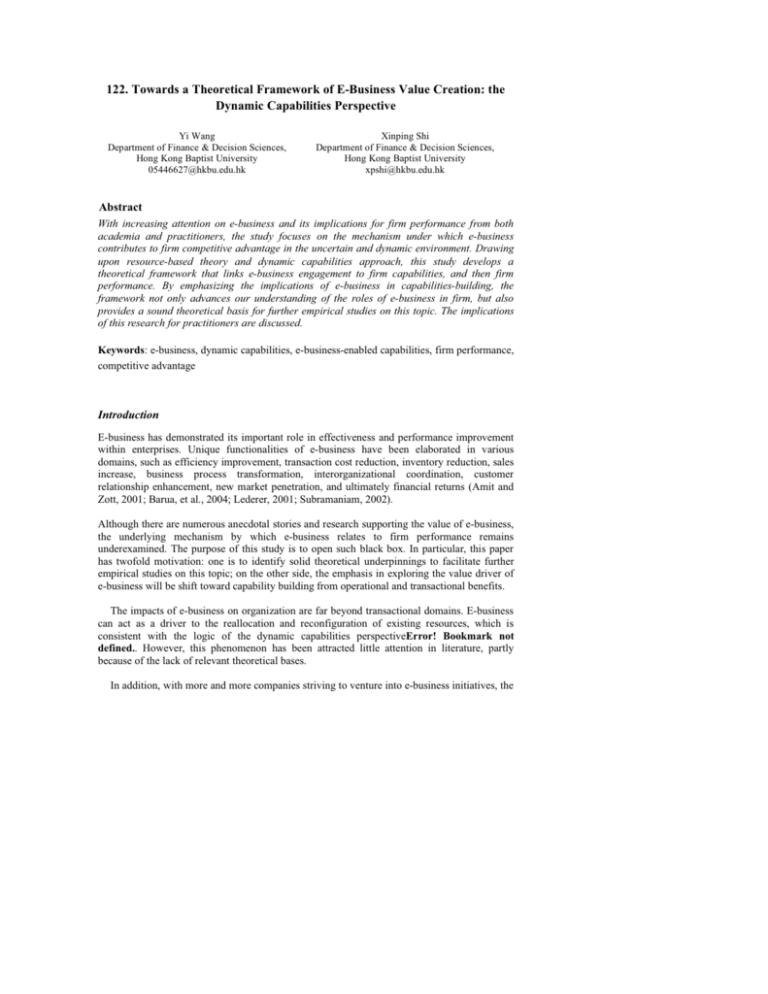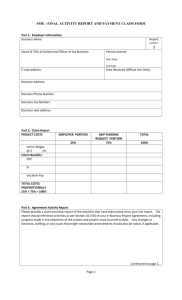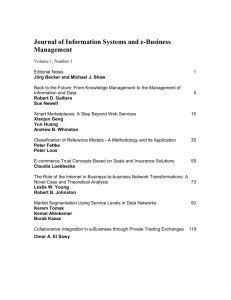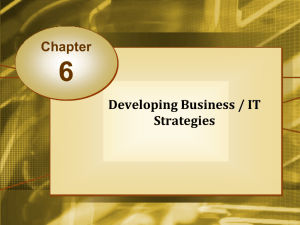122. Towards a Theoretical Framework of E-Business Value
advertisement

122. Towards a Theoretical Framework of E-Business Value Creation: the Dynamic Capabilities Perspective Yi Wang Department of Finance & Decision Sciences, Hong Kong Baptist University 05446627@hkbu.edu.hk Xinping Shi Department of Finance & Decision Sciences, Hong Kong Baptist University xpshi@hkbu.edu.hk Abstract With increasing attention on e-business and its implications for firm performance from both academia and practitioners, the study focuses on the mechanism under which e-business contributes to firm competitive advantage in the uncertain and dynamic environment. Drawing upon resource-based theory and dynamic capabilities approach, this study develops a theoretical framework that links e-business engagement to firm capabilities, and then firm performance. By emphasizing the implications of e-business in capabilities-building, the framework not only advances our understanding of the roles of e-business in firm, but also provides a sound theoretical basis for further empirical studies on this topic. The implications of this research for practitioners are discussed. Keywords: e-business, dynamic capabilities, e-business-enabled capabilities, firm performance, competitive advantage Introduction E-business has demonstrated its important role in effectiveness and performance improvement within enterprises. Unique functionalities of e-business have been elaborated in various domains, such as efficiency improvement, transaction cost reduction, inventory reduction, sales increase, business process transformation, interorganizational coordination, customer relationship enhancement, new market penetration, and ultimately financial returns (Amit and Zott, 2001; Barua, et al., 2004; Lederer, 2001; Subramaniam, 2002). Although there are numerous anecdotal stories and research supporting the value of e-business, the underlying mechanism by which e-business relates to firm performance remains underexamined. The purpose of this study is to open such black box. In particular, this paper has twofold motivation: one is to identify solid theoretical underpinnings to facilitate further empirical studies on this topic; on the other side, the emphasis in exploring the value driver of e-business will be shift toward capability building from operational and transactional benefits. The impacts of e-business on organization are far beyond transactional domains. E-business can act as a driver to the reallocation and reconfiguration of existing resources, which is consistent with the logic of the dynamic capabilities perspectiveError! Bookmark not defined.. However, this phenomenon has been attracted little attention in literature, partly because of the lack of relevant theoretical bases. In addition, with more and more companies striving to venture into e-business initiatives, the potential of e-business to generate comparative benefits for implementing companies may be under question. The most crucial question managers are continuously engaged in is not whether to implement e-business, but how to apply e-business and gain competitive advantage from such investment. However, the existing literature cannot afford this probe. The mechanism underlying which firm benefits from e-business engagement is far from fully understood. To address these research gaps, this study reviews relevant literature, in particular resourcebased view of firm, and dynamic capabilities approach. In addition, accumulated knowledge from literature on e-business value creation contributes to understanding of this topic. A theoretical framework is developed based on the dynamic capabilities perspective to demonstrate the relationship among e-business, firm capabilities enabled by e-business, and firm competitive advantage. Finally, testable hypotheses have also been developed. Theoretical Foundation Resource-Based View Resource-based view of firm is mainly addressing the following questions: (1) what resources can contribute to firm competitive advantage? and (2) how these resources enable a firm to achieve superior performance and keep competitive in its industry? (Barney, 1991; Eisenhardt and Martin, 2000; Teece, et al., 1997). The RBV views firm as a combination of various resources and capabilities (Amit and Zott, 2001). By assuming resource heterogeneity and immobility (Barney, 1991), resource-based theory suggests resources, which are rare, valuable, imitable, and nonsubstitutable, can contribute to superior firm performance and sustained competitive advantage. Contrary to Porter’s environmental model of competitive advantage (Porter, 1980), RBV focuses on the impact of internal firm resources on firm performance. Wade and Hulland (2004) conduct a literature review on IT resources and their impact on firm performance. They explicitly distinguish the concept of capabilities from assets by defining capabilities as “repeatable patterns of actions in the use of assets”(Wade and Hulland, 2004). In the hierarchy of IT resources, capabilities are higher-order resources that refer to the ability of a firm to incorporate IT assets into organizational processes to improve performance (Barua, et al., 2004). RBV is relevant in e-business context. With the time compression nature of internet world and factor market imperfection, firms have to build by themselves specific resources and capabilities which are required to support their business operation. For example, good relationships with customers and partners, well-established reputations, and fast market responsiveness are especially critical factors for firms engaging in e-business. In addition, complementarities between various resources and capabilities, like online and offline capabilities, different task-specific capabilities, and those embedded in business process are not easily imitated and substituted by other competitors, and thus provide firms competitive advantage. By identifying valuable, rare, imitable, and not easily substitutable resources closely related to e-business, resource-based theory is helpful in improving our understanding of ebusiness value creation. Dynamic Capabilities Approach Unlike traditional RBV that views firm resources relative static and slack, Teece et al creatively define dynamic capabilities as “the ability to achieve new forms of competitive advantage” (Teece, et al., 1997), which is believed more relevant to uncertain and changing environment. The term “dynamic” focuses on firm capacity to renew existing competences to adapt to the changing environment. Dynamic capabilities are distinctive in serving as an enabler that facilitates reconfiguring and disposing other resources. The dynamic capabilities contribute to firm competitive advantages in three fundamental ways: reconfiguring extant resources, gaining additional resources and enhancing the productivity of other resources. Dynamic capabilities approach expands its focus to the rapidly changing environment and argues that there is different principle determining organizational performance in competition in such context. This probation purposely strengthens RBV’s explanation power in firm performance by assuming the dynamic nature of firm resources. Recognizing the relevance of this approach to value creation in the changing world, e-business researchers have begun to apply the perspective to investigating e-business value. Zhu (2004) views e-commerce a higher-order capability that requires alignment among organizational factors, changing technology and business environments. Echoing Zhu’s (2004) call for investigation of dynamic nature of e-commerce capability, Khawaja et al (2005) introduce the e-commerce competence construct. These studies do demonstrate that e-business initiatives have significant implications in organizational transformation in terms of business process, resource allocation, and appropriation of IT-related benefits. No study, however, explicitly specifies the dynamic nature of e-business-enabled capabilities, that is, the important role of ebusiness in reconfiguring firm resources and then generating sustainable competitive advantage. The conceptualization and operationalizaiton of e-commerce capabilities are limited, and fail to capture the impact of e-commerce capabilities on other organizational resources and capabilities. Consistent with IT-related RBV literature, this study proposes that e-business serves as a resource enabler or catalyst that supports organizations in reconfiguring resources and capitalizing on opportunities to adapt to the fast-changing environment. Further, we term the concept e-business-enabled capabilities and argue these capabilities are of dynamic nature that can reconfigure and renew firm resources, such as e-business technologies, workforce, physical assets, and relationships with customers and suppliers. Teece (1997) identifies three main processes that are determinative for firm dynamic capabilities: coordination/integration among resources, learning, and reconfiguration in a dynamic environment. Integrating the literature review, we conceptualize e-business-enabled capabilities as the following aspects: (a) sensing market, (b) learning, and (c) coordination. We will elaborate the relationships between ebusiness and these four capabilities in following section. Research Model E-business enabled capabilities: Sensing market H4 H1 E-business adoption H2 H5 Learning Competitive advantage H3 Coordination H6 Control VARs: Firm size Information intensity of ind Figure 5 Research Model ustry E-Business-Enabled Capabilities We have identified three dimensions of e-business-enabled capabilities as market sensing, organizational learning, and coordination. The following hypotheses address the relationships among e-business and the specific capabilities. Sensing market is the process with which a firm understands external environment and market conditions, including customer demands, competitors moves, market trends, and as well as its own resource gaps. Firms engaging in high-level e-business may obtain superior market sensing capabilities compared to their counterparts. For example, online selling implementation allows a firm to cost-effectively communicate and interact with its potential and existing customers in a customized way. The speed and richness with which information can be exchanged and processed by the Internet and Web-based applications enable fast access of market information. In addition, a firm conducting e-business tends to attain an international horizon which may broaden its business territory. Therefore the following hypothesis is set forth: H1: Firms engaging in higher levels of e-business adoption will have greater levels of market-sensing capabilities. Organizational learning capabilities refer to the ability to recognize the value of information, assimilate it into business process and strategic design, and capitalize on it (Cohen and Levinthal, 1990). E-business applications can provide companies with these capabilities by accumulating proprietary knowledge, such as online customers shopping history, and preempting scarce resources (Amit and Zott, 2001). A firm with higher level of e-business engagement possesses the advanced communication channel and method which are prerequisite to obtain useful knowledge from internal employees and external partners. Moreover, the increased collaborations and partnerships pervasively occurring in e-business context provide “a vehicle for new organizational learning, helping firms to recognize dysfunctional routines, and preventing strategic blindspots” (Teece, et al., 1997). Thus, we put forward the following hypothesis: H2: Firms engaging in higher levels of e-business adoption will have greater levels of learning capabilities. Coordination capability is defined as the ability to orchestrate and match various resources, tasks and perform activities within or across firm to capture effectiveness. Coordination serves to remove barriers of information, material, and work flow among interplayed entities to smooth activities or business processes which require involvement of various actors or resources. E-business can enable coordination capabilities of an organization by reducing coordination cost and improving coordination efficiency. On the other hand, internet-based ebusiness help increase flexibility in supply chain (Gosain, et al., 2004) and thereby eliminate some barriers to coordination between companies and their partners. This leads to the following hypothesis: H3: Firms engaging in higher levels of e-business adoption will have greater levels of coordination capabilities. Linking E-Business-Enabled Capabilities to Firm Performance The ability of sensing market can contribute to firm performance in terms of helping identify new market opportunities (Day, 1994), detect attractive new combinations of resources(Galunic and Rodan, 1998), and improve market responsiveness. Firms with greater market orientation tend to respond to market changes more proactively and rapidly. This allows them to develop and deliver new products and service to fulfill changing customer needs and create more value to customers. H4: The greater market sensing capabilities, the greater competitive advantages. The important role of organizational learning in enhancing firm competitive advantage has been extensively supported (Grant, 1996; Lei, et al., 1996; Simonin, 1997). Tippins et al.(2003) further state that IT competence itself cannot directly influence business value and its impact on firm performance is mediated by organizational learning. H5: The greater organizational learning capabilities, the greater competitive advantages. Coordinative capability in itself is a form of managerial ability. A firm with high coordination with its partners can largely reduce coordination costs and increase communication and interaction effectiveness. Coordination capabilities which are deeply embedded in managerial and business process can improve effectiveness through design of business processes. The coherence of business processes makes the replication of coordinative capabilities difficult (Teece, et al., 1997) and thereby coordination is identified as a source of sustainable competitive advantage. H6: The greater e-business-enabled coordination capabilities, the greater competitive advantages. Control Variables Since firm size may represent several important aspects of the organization, including resource availability, decision agility, and prior technology experience, it may affect the impact of ebusiness on firm performance. Thus, we include firm size to control for its possible effect. The existence of industry factors may also confound our analysis. Information intensity is defined as the degree to which a firm’s business operations are relied upon information collection and process (Hu and Quan, 2005). The rationale of incorporating information intensity of an industry is that firms conducting business in an industry with high information intensity, such as banking, financial and insurance companies may benefit more from IT-related investments than those with low information intensity, such as energy, mining, and construction. Conclusion The proposed conceptual model and associated hypotheses will be tested by survey data because of its advantages in theory development and statistical power (Teo, et al., 2003). The unit of analysis is firm engaging in e-business. Primary data will be collected through a welldesigned questionnaire. The operationalization of the constructs in the model should be adopted from the existing literature as much as possible. The identified theoretical framework advances our understanding of nature and unique roles of e-business in firm performance and competitive advantage. The e-business-enabled capability perspective provides a generalizable framework to examine the role of e-business in firm capabilities-building, and then its implications for firm competitive advantage. This study also can improve practitioners understanding of e-business implementation and its impacts on firm performance. With more competitors tapping into this area, the first mover advantage will gradually diminish. Therefore, firms aim at survival and success in the uncertain and changing environment should broaden their vision and focus on the critical function of e-business as a capability-enabler within organization. References Amit, R., and Zott, C. "Value Creation in E-business," Strategic Management Journal (22:6/7), 2001, pp. 493-520. Barney, J.B. "Firm Resources and Sustained Competitive Advantage," Journal of Management (17:1), 1991, pp. 99-120. Barua, A., Konana, P., Whinston, A.B., and Yin, F. "An Empirical Investigation of Net-Enabled Business Value," MIS Quarterly (28:4), 2004, pp. 585-620. Cohen, W.M., and Levinthal, D.A. "Absorptive Capacity: A New Perspective on Learning and Innovation," Administrative Science Quarterly (35:1), 1990, pp. 128-152. Day, G.S. "The Capabilities of Market-Driven Organizations," Journal of Marketing (58:4), 1994, pp. 37-52. Eisenhardt, K.M., and Martin, J.A. "Dynamic Capabilities: What Are They?" Strategic Management Journal (21:10-11), 2000, pp. 1105-1121. Galunic, D.C., and Rodan, S. "Resource Recombinations in the Firm: Knowledge Structures and the Potential for Schumpeterian Innovation," Strategic Management Journal (19:12), 1998, pp. 1193-1201. Gosain, S., Malhotra, A., and El Sawy, O.A. "Coordinating for Flexibility in e-Business Supply Chains," Journal of Management Information Systems (21:3), 2004, pp. 7-45. Grant, R.M. "Toward a Knowledge-based Theory of the Firm," Strategic Management Journal (17:WINTER), 1996, pp. 109-122. Hu, Q., and Quan, J. "Evaluating the Impact of IT Investments on Productivity: A Causal Analysis at Industry Level," International Journal of Information Management (25:1), 2005, pp. 39-53. Khawaja, A.S., Varun, G., and Yujong, H. "The Relationship of E-Commerce Competence to Customer Value and Firm Performance: An Empirical Investigation," Journal of Management Information Systems (22:1), 2005, pp. 223-256. Lederer, A.L. "The Search for Strategic Advantage from the World Wide Web," International Journal of Electronic Commerce (5:4), 2001, pp. 117-133. Lei, D., Hitt, M.A., and Bettis, R. "Dynamic Core Competences through Meta-Learning and Strategic Context," Journal of Management (22:4), 1996, pp. 549-569. Porter, M., E. Competitive Strategy, New York: The Free Press, 1980. Simonin, B.L. "The Importance of Collaborative Know-How: An Empirical Test of the Learning Organization," The Academy of Management Journal (40:5), 1997, pp. 11501174. Subramaniam, C. "A Study of the Value and Impact of B2B E-Commerce: The Case of WebBased Procurement," International Journal of Electronic Commerce (6:4), 2002, pp. 19-40. Teece, D.J., Pisano, G., and Shuen, A. "Dynamic Capabilities and Strategic Management," Strategic Management Journal (18:7), 1997, pp. 509-533. Teo, H.H., Wei, K.K., and Benbasat, I. "Predicting Intention to Adopt Interorganizational Linkages: An Institutional Perspective," MIS Quarterly (27:1), 2003, pp. 19-49. Tippins, M.J., and Sohi, R.S. "IT Competency and Firm Performance: Is Organizational Learning a Missing Link?" Strategic Management Journal (24:8), 2003, pp. 745-761. Wade, M., and Hulland, J. "Review: The Resource-based View and Information Systems Research: Review, Extension, and Suggestions for Future Research," MIS Quarterly (28:1), 2004, pp. 107-142. Zhu, K. "The Complementarity of Information Technology Infrastructure and E-Commerce Capability: A Resource-Based Assessment of Their Business Value," Journal of Management Information Systems (21:1), 2004, pp. 167-202.








